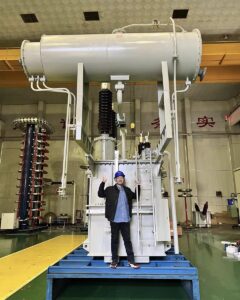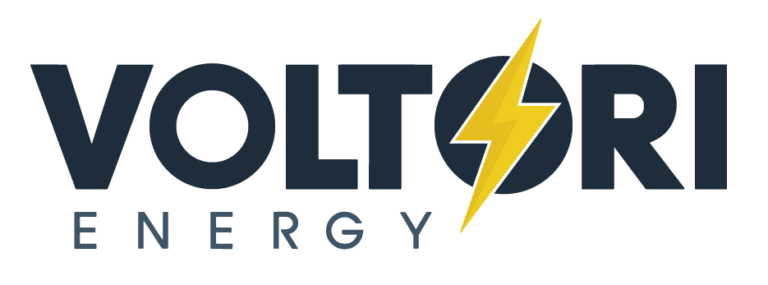Power transmission faces a critical problem: electricity loses energy as heat during long-distance delivery. Without proper voltage management, your lights might flicker or fail completely.
Step-up transformers in power stations increase voltage before transmission to reduce energy loss. They convert low-voltage electricity (typically 11-25kV) generated at power plants to high-voltage electricity (132-765kV) for efficient long-distance transmission, minimizing power loss through heat dissipation.

Understanding transformers might seem complex, but they're essential for delivering reliable electricity to our homes and businesses. These devices ensure that the power generated at plants reaches us efficiently, despite traveling hundreds of kilometers through transmission lines.
Why Do Power Stations Use Step-Up Transformers?
Power plants generate electricity at relatively low voltages, but sending it this way would waste enormous amounts of energy and require impossibly thick cables.
Power stations use step-up transformers because transmitting electricity at higher voltages dramatically reduces energy losses. When voltage increases and current decreases (while maintaining the same power), heating losses in transmission lines decrease by the square of the current reduction, making long-distance power delivery economically viable.

Step-up transformers solve a fundamental physics problem in electricity distribution. Let me explain this more thoroughly by examining the core benefits they provide.
Economic Benefits of High-Voltage Transmission
Step-up transformers make our entire power grid financially viable. Without them, delivering electricity would be prohibitively expensive. Here's why:
| Aspect | Low-Voltage Transmission | High-Voltage Transmission |
|---|---|---|
| Cable Requirements | Extremely thick, expensive copper cables | Thinner, more affordable cables |
| Material Costs | Very high due to copper volume | Significantly lower |
| Power Loss | Up to 80-90% over long distances | As low as 2-3% over the same distance |
| Infrastructure Needs | More substations required | Fewer substations needed |
I've visited power stations where the step-up transformers are truly massive - some standing over 6 meters tall. These aren't just big because engineers like large equipment; their size directly reflects the voltage conversion requirements and power handling capacity needed for our national grid.
The physics behind this is straightforward: power loss in transmission is calculated as I²R (current squared multiplied by resistance). When we step up voltage by a factor of 10, we reduce current by the same factor, which reduces power loss by a factor of 100. This makes transmitting power across hundreds of kilometers practical and affordable.
What Is The Purpose Of A Transformer In A Power Station?
Electricity must travel efficiently from generation sources to homes and businesses, but the voltage needs at each stage are drastically different.
The purpose of transformers in power stations is to modify voltage levels between generation, transmission, and distribution networks. They act as voltage converters, allowing electricity to be stepped up for efficient transmission or stepped down for safe residential use, effectively bridging different parts of the electrical grid.

Transformers are truly the unsung heroes of our electrical system. Although their basic technology hasn't changed dramatically in over a century, they remain essential components that enable our modern electrical infrastructure to function.
Types of Transformers in Power Systems
Transformers serve different functions depending on where they're positioned in the power network. I often explain this to clients who are setting up renewable energy systems and need to understand how their power will integrate with the grid.
| Type | Location | Primary Function | Typical Voltage Conversion |
|---|---|---|---|
| Generator Transformer | Power Plant | Steps up voltage from generators | 11-25kV to 132-765kV |
| Transmission Transformer | Transmission Substations | Adjusts voltage for transmission network | 132-765kV to 132-765kV |
| Distribution Transformer | Distribution Substations | Steps down voltage for local distribution | 132kV to 11-33kV |
| Service Transformer | Neighborhoods/Poles | Final step-down for consumer use | 11kV to 120/240V |
Each transformer type has specialized design characteristics based on its function. For instance, in our recent installation at a solar farm in British Columbia, we provided a generator-type transformer that had to handle variable inputs from the photovoltaic array while maintaining a consistent output to the grid.
Transformers also provide isolation between different sections of the power system, protecting equipment and enhancing safety. This isolation function is critical for preventing cascading failures across the grid during fault conditions. I remember when lightning struck near one of our installations - the transformer prevented the surge from damaging equipment downstream, saving our client thousands in potential repairs.
What Is The Purpose Of A Step Up Transformer?
Electrical generators produce power at relatively low voltages, but this would result in massive energy waste and require impractically large cables for long-distance delivery.
A step-up transformer converts low-voltage, high-current electricity to high-voltage, low-current electricity while maintaining the same power level. This transformation reduces transmission losses, enables the use of thinner transmission lines, and makes long-distance power distribution economically viable and efficient.

Step-up transformers operate on electromagnetic induction principles that have remained fundamentally unchanged for over a century. Yet they continue to be improved through better materials and design techniques.
Step-up Transformers: Working Principles and Applications
The operation of step-up transformers relies on electromagnetic principles discovered by Michael Faraday, but their practical implementations are engineering marvels. At Voltori Energy, we design these transformers with precise calculations to meet specific requirements.
Core Working Principles:
-
Turn Ratio: The voltage increase is directly proportional to the turns ratio between primary and secondary windings. If the secondary winding has 10 times more turns than the primary, the output voltage will be 10 times higher.
-
Magnetic Core: The core, typically made from specialty silicon steel laminations, channels magnetic flux between windings with minimal losses.
-
Power Conservation: While voltage increases, current decreases proportionally, keeping power (V × I) theoretically constant (minus efficiency losses).
| Parameter | Input Side (Low Voltage) | Output Side (High Voltage) |
|---|---|---|
| Voltage | Lower (e.g., 25kV) | Higher (e.g., 500kV) |
| Current | Higher | Lower |
| Winding Turns | Fewer | More |
| Wire Thickness | Thicker | Thinner |
| Power | Same (minus losses) | Same (minus losses) |
In modern renewable energy applications, step-up transformers have become increasingly important. For example, in a wind farm project I consulted on last year, each turbine had its own small step-up transformer to match the generated voltage to the farm's collection system. Then, a larger main transformer stepped up the voltage again for grid connection. This multi-stage approach maximizes efficiency while accommodating the variable nature of wind power generation.
The design of these transformers must account for factors like harmonics from inverters in solar installations, voltage regulation needs, and extreme weather conditions that might affect cooling systems. Each transformer we build at Voltori is custom-engineered to address these specific challenges.
Why Is A Step Down Transformer Used In A Sub Power Station?
The high voltage electricity arriving at substations is extremely dangerous and incompatible with household appliances and industrial equipment we use daily.
Step-down transformers in substations reduce transmission-level high voltages (132-765kV) to lower distribution voltages (11-33kV) and eventually to utilization voltages (120-480V). This makes electricity safe for consumer use, compatible with household devices, and appropriate for local distribution networks.

Substation transformers form a critical link between the bulk power system and our everyday electricity use. They're designed with multiple safeguards since they bridge the gap between dangerous high voltages and the electricity that powers our homes and workplaces.
Substation Transformer Systems: A Closer Look
Substation transformer installations are sophisticated systems that do far more than just step down voltage. They incorporate various protective elements and monitoring systems to ensure reliable power delivery.
Key Components in Substation Transformer Systems:
| Component | Function | Importance |
|---|---|---|
| Tap Changers | Allow voltage adjustment without interrupting power | Maintains stable voltage despite load changes |
| Cooling Systems | Remove heat generated during operation | Extends transformer life and maintains efficiency |
| Bushings | Insulate and connect transformer windings to external circuits | Critical safety components preventing flashovers |
| Protection Relays | Monitor conditions and disconnect during faults | Prevent catastrophic failures and fires |
| Oil or Insulating Medium | Provides electrical insulation and cooling | Essential for transformer operation and safety |
I recently visited a suburban substation where the transformation happens in several stages. First, incoming 230kV transmission voltage is stepped down to 69kV for regional distribution. Then, another transformer reduces it to 12kV for neighborhood circuits. Finally, pole-mounted or pad-mounted transformers further reduce voltage to 120/240V for residential use.
The engineering challenges in designing these transformers are significant. They must handle daily load fluctuations, withstand occasional overloads, survive lightning strikes and other environmental hazards, and operate reliably for 25-40 years with minimal maintenance. At Voltori Energy, our designs incorporate temperature monitoring systems that track hotspots inside the transformer, allowing for predictive maintenance rather than reactive repairs.
An interesting aspect of modern substation transformers is their role in renewable energy integration. As more distributed generation comes online, these transformers must handle bidirectional power flow - something they weren't originally designed for. This is why we've developed special models with advanced monitoring capabilities to handle the changing nature of our electrical grid.
Conclusion
Step-up transformers make efficient electricity transmission possible by increasing voltage and reducing current, while step-down transformers ensure safe delivery to end users. Both are essential links in our power system chain.
Experience Voltori Energy's custom-engineered transformers for your renewable energy projects—designed specifically for Canadian conditions and standards.




